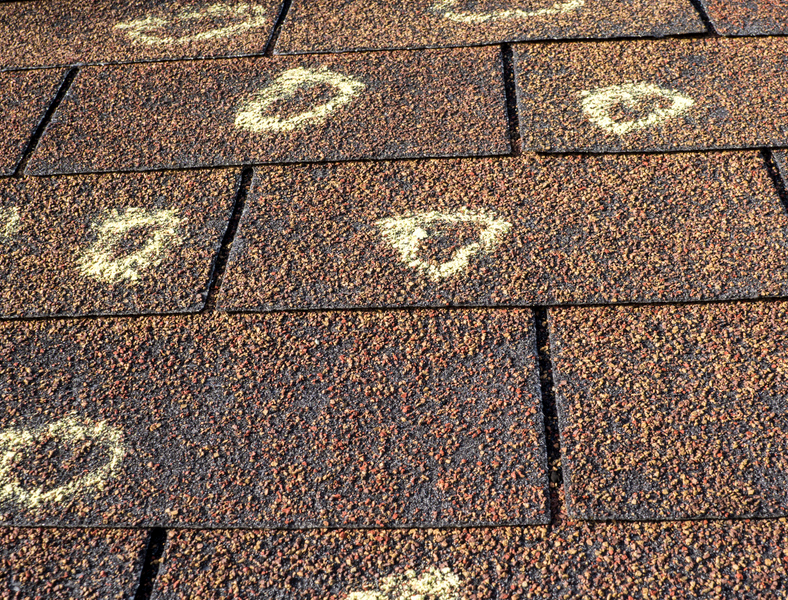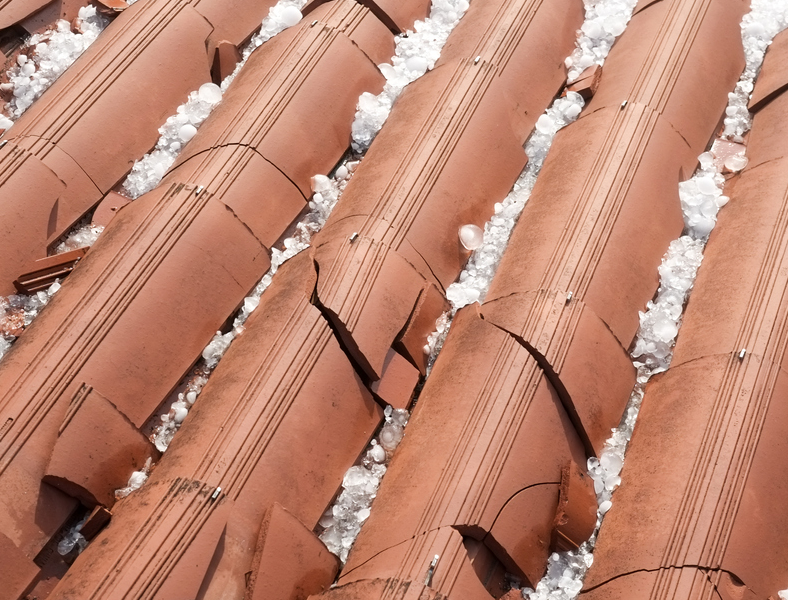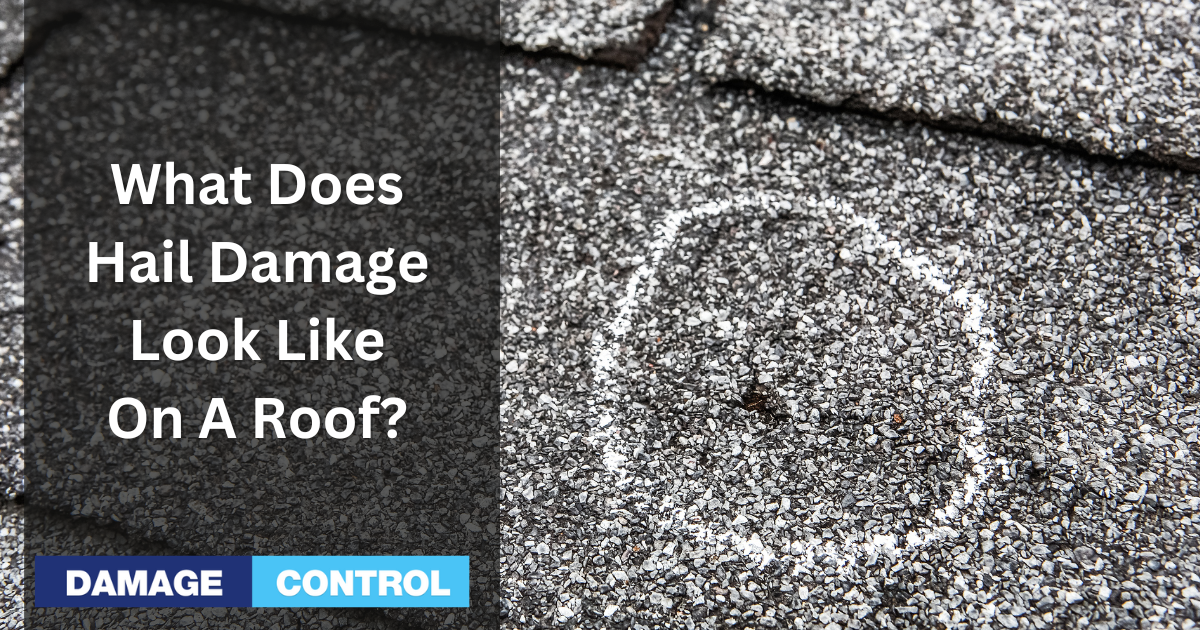Hailstorms can wreak havoc on roofs, leaving homeowners with costly repairs. In this guide, we'll explore the impact of hail on roofs and emphasize the importance of timely repair and maintenance. So, grab your toolbelt, and let's dive in!
What Causes Hail Damage?

How is hail formed?
Ever wonder how hail comes to be? It's a fascinating process, really. Hailstones are formed when strong updrafts carry raindrops into freezing-cold layers of the atmosphere. There, the raindrops freeze, and as they fall back down, they collect more water, which freezes too. This cycle continues until the hailstones become too heavy for the updrafts, and they plummet down to earth onto our roofs.
What are the common types of hail damage to roofs?
Hail damage can take various forms, each posing its own challenges. Let's take a closer look at some of the most common types of hail damage to roofs:
Bruising and denting
Hailstones can leave visible dents and bruises on your roof's surface. These blemishes might not seem like a big deal, but they can weaken your roof's integrity, making it more susceptible to leaks and other issues. This one is the silent killer of roofs. Bruising and denting can be light from the naked eye, almost impossible to see from the ground. It's not much easier with an on-roof visual inspection.
Cracking and splitting
When hailstones strike your roof with enough force, they can cause shingles to crack or split. These openings create entry points for water, leading to leaks and potential water damage inside your home. Cracking and splitting happen in three general situations.
- Shingles were cold when impacted by hailstones.
- Shingles were older and brittle.
- Larger hailstones impacted them.
Granule loss
Hail knocks off the protective granules on your shingles, exposing the asphalt underneath to the sun's U.V. rays, deteriorating the asphalt. Over time, wear and tear speeds up, reducing the lifespan of your roof. A new roof of three years old can need replacement by year six if falling hailstones dislodge enough granules. Entropy is tough on asphalt when the sun is the main weapon.
Exposed underlayment and decking
In severe cases, hail can cause enough damage to expose the underlayment and decking beneath your shingles. This leaves your home extremely vulnerable to water infiltration and further damage. If this has happened to you, immediately call your local roofing contractor to place emergency tarps on your roof until solutions can be implemented.
Understanding these common types of hail damage is the first step in protecting your roof and ensuring its longevity. Keep an eye out for these signs and take action promptly when you spot them.
What Does Hail Damage Look Like On A Roof?
 What are the signs of roof hail damage?
What are the signs of roof hail damage?
Detecting hail damage early is crucial to preventing further issues. Keep an eye out for these telltale signs:
Visible dents on shingles
After a hailstorm, check for dents or dimples on your shingles. These may be small, but they indicate potential structural damage.
Damaged or broken shingles
Inspect your roof for cracked, broken, or missing shingles. These are often caused by hailstones hitting with enough force to cause visible damage.
Granules in gutters
Finding granules in your gutters is one sign that hail has dislodged them from your shingles, but an aged roof will do the same if older than seven years. It's a pretty good indicator of hail damage if the roof is under five years old. Past that, you need other evidence to back the theory of causation. There are many ways to accomplish this task with the help of the web and professional roofing contractors.
Leaks and water damage
Look for water stains on your ceilings or walls, which may signal a leaky roof due to hail damage. Checking the attic for wet insulation would also be a great idea. Depending on how small or large the leak(s), you can have damage in the attic and on the roof structure itself before seeing any damage inside the finished home. There are many reasons why every homeowner should own moisture meters.
How should I inspect my roof after a hailstorm?
Safety precautions
Safety first! Before inspecting your roof, ensure you're wearing the appropriate gear, such as non-slip shoes and a safety harness. If you're uncomfortable or inexperienced, consider hiring a professional. In fact, hiring a professional when dealing with hail damage would be most prudent.
They will see the damage you miss. They also have drones with specialized cameras and software to give positive ID on hail damage. They also know how to deal with insurance adjusters to ensure you don't get ripped off.
What to look for
While inspecting, focus on these key areas:
- Shingles: Examine for dents, cracks, or missing granules.
- Gutters: Check for granule buildup or dents from hailstones.
- Flashing and vents: Look for dents or other signs of damage.
- Skylights and windows: Inspect for cracked or broken glass caused by hail.
Remember, early detection of hail damage is crucial to prevent further problems. Remember these tips and stay proactive in maintaining your roof's health.
Hail Damage Roof Repair: Fixing Your Roof after a Storm
Has your roof recently suffered from hail damage? Don't worry, I've got you covered with some helpful tips on how to repair it! Whether you're considering a DIY approach or seeking professional assistance, let's explore the best options for getting your roof back in top shape.
DIY Repairs
- Replacing Damaged Shingles: If you're comfortable working on your roof, you can tackle shingle replacements yourself. Start by carefully removing the damaged shingles using a pry bar. Then, slide the new shingle into place, ensuring it aligns with the surrounding ones. Use roofing nails to secure it and seal the edges with roofing cement for added protection.
- Fixing Dents and Cracks: Hail can leave dents and cracks on your roof's surface. To address this, gently tap out the dents using a rubber mallet or a block of wood. For cracks, apply roofing sealant along the damaged area to prevent water from seeping in.
When to Call a Professional
- Assessing the Extent of Damage: It's crucial to assess the extent of hail damage before deciding whether to call a professional. If the damage is limited to a few shingles or minor dents, you may be able to handle the repairs yourself. However, it's wise to seek professional assistance if the damage is widespread or severe.
- Finding a Reliable Roofing Contractor: When searching for a roofing contractor, ask for recommendations from friends, family, or neighbors who have recently had roof repairs done. Additionally, check online reviews and verify their licensing and insurance. A reliable contractor will provide a thorough assessment, a detailed estimate, and quality workmanship to restore your roof effectively. They will also help with your adjuster.
Remember, safety should always be your top priority. If you're uncomfortable working at heights or unsure about the repairs, it's best to leave it to the professionals. With their expertise, you can have peace of mind knowing that your roof will be repaired properly, protecting your home from further damage.
Is Your Home Covered for Hail Damage?
How Do You Navigate Your Homeowners' Insurance Policy?
Homeowners' insurance policies can be a maze. But don't worry! We're here to guide you through it. You see, your policy's got your back when it comes to hail damage. It's usually part of the standard coverage. However, it's wise to double-check. Keep an eye out for any exclusions or limitations.
How to File a Hail Damage Claim: Steps to Success
What's the Best Way to Document the Damage?
First things first: snap some photos. Capture every angle of the damage. The more pictures, the better. Remember to grab a shot of the hailstones themselves. Use a ruler or any common object for size reference. This evidence is your key to a successful claim.
How Do You Work with an Insurance Adjuster?
Next up, say hello to your insurance adjuster. They'll inspect the damage and determine the cost. Be prepared for their visit. Have your documentation and policy number handy. Cooperation is key. Keep the communication lines open and work together to ensure a fair assessment.
What to Do If You're Facing Claim Disputes
Disagreements happen, but don't let that discourage you. If you're facing a claim dispute, there are steps you can take. First, review your policy and documentation. Make sure you're clear on the coverage and requirements. Still not satisfied? Hire a public adjuster. They'll provide an independent assessment and advocate on your behalf. Finally, if all else fails, consider consulting an attorney.
Hail damage can be a headache, but you're not alone. Your homeowners' insurance policy is there to support you. Remember to double-check your coverage, document the damage, and work closely with your adjuster.
How Can You Prevent Hail Damage to Your Home?
What Roofing Materials Can Help Protect Against Hail Damage?
Are Impact-Resistant Shingles a Good Choice?
The roof takes the brunt of hail's fury. So, choose your materials wisely. Impact-resistant shingles? Now that's a smart move. These sturdy soldiers are designed to withstand the harshest weather. They've got a Class 4 impact rating, which is the highest in the game. Trust us; your roof will thank you. Fiberglass roofing panels are a solution for greenhouses and other types of outdoor buildings.
What About Metal Roofing?
Metal roofing? Another fantastic option! It's not just sleek and stylish. It's also super durable. The best part? It can handle hail like a champ. Plus, it's eco-friendly and energy-efficient. So, why not give it some thought?
How Can You Install Protective Features to Guard Against Hail Damage?
Should You Consider Roof Ridge Guards?
Roof ridge guards? They're a game-changer. These sturdy protectors shield your roof's most vulnerable spots. And guess what? They're designed to keep out wind-driven rain, too. So, go ahead and give your roof the armor it deserves.
What About Hail Guards for Vents and Skylights?
Don't forget your vents and skylights! Hail can wreak havoc on them, too. But fear not – hail guards are here to save the day. These nifty devices safeguard your vents and skylights from hail's wrath. Simple to install, and peace of mind guaranteed.
In a nutshell, preventing hail damage is all about being proactive. Invest in impact-resistant shingles or one of the many options for metal roofing, and consider adding protective features like roof ridge guards and hail guards. A little effort now can save you a whole lot of trouble later. Stay safe, and protect your home from hail's fury!
Frequently Asked Questions: Let's Talk Hail Damage
How Big Must Hail Be to Cause Roof Damage?
Size matters! But even small hailstones can pack a punch. Generally, hailstones 1 inch in diameter or larger can cause roof damage. However, don't underestimate the smaller ones. High winds and a barrage of tiny hailstones can still leave their mark.
When Should You Inspect Your Roof After a Hailstorm?
Act fast! Inspect your roof as soon as it's safe. The sooner you spot the damage, the better. You'll prevent leaks, mold, and other issues from worsening. Plus, you'll have a head start when it comes to filing an insurance claim.
DIY or Pro: Who Should Repair Hail Damage?
To DIY or not to DIY, that's the question. Minor damage? You might be able to handle it yourself. But if you're not an experienced roofer, think twice. Hail damage can be tricky to fix. A professional has the skills and tools to do the job right. Better safe than sorry!
Will Insurance Cover Hail Damage Repair Costs?
Good news: most homeowners' insurance policies cover hail damage. But it's crucial to double-check your policy. Look for any exclusions or limitations. And remember, your deductible will still apply. Make sure to file a claim promptly and provide all necessary documentation.
What Can You Do to Prevent Future Hail Damage?
Protect your roof like a pro. Choose impact-resistant shingles or metal roofing to ward off hail's wrath. Install roof ridge guards and hail guards for vents and skylights. These preventive measures can save you from costly repairs in the long run.
There you have it! Your hail damage FAQs answered. Stay vigilant, keep your roof in top shape, and be prepared for whatever Mother Nature throws your way.
Conclusion
Now that we've covered the ins and outs of hail damage, it's time to dive deeper into the world of roofing. Ready to expand your knowledge and explore more options? We've got you covered!
Interested in learning about a product that acts as a stain remover for roofing? We've got the details on how to keep your roof looking clean and pristine. If you're curious about flat fiberglass options, our article will help you understand the benefits and considerations of this material.
For those intrigued by built-up roofing, you'll want to explore the various materials used in built-up roofing to get the lowdown on this popular choice.
Your roofing journey doesn't end here! Keep exploring, learning, and upgrading your roofing knowledge. Remember, a well-informed homeowner is a well-protected homeowner.

